When summer finally arrives, many of us are eager to load up the car and escape from the city. A weekend in the great outdoors can be just the thing to de-stress and enjoy time with loved ones.
Unfortunately, roughing it can be hard on the body. Sleeping in a tent without a proper bed or sitting in a canvas camping chair can bring on aches and pains, as can hauling heavy gear in and out of the car. Folks who enjoy hiking, climbing, and similar pursuits can experience muscle soreness or even strains or sprains.
6 tips to avoid back pain and injury while camping:
1. Stay Hydrated
Whether you’re sitting around a campsite or scrambling up a mountain, it’s important to stay hydrated in warm weather. Drinking lots of water will help avoid heat exhaustion and heat stroke, but also back pain, as dehydration causes the body’s tissues to become stiff and sore.
If you need to bring your own potable water, make sure you bring more than you think you’ll need — even if your trunk is already packed tight. You can learn more about staying hydrated here.
2. Have the right outdoor gear
Bring the right gear for your outdoor activities. Hikers can minimize strain on the lower back and the stress on their joints by wearing proper hiking shoes with good cushioning and suitable ankle and arch support. A well-fitting backpack that distributes weight evenly and bears load in the proper areas is also important in avoiding neck, upper, and lower back pain. If you’re climbing, make sure your shoes are broken in to avoid blisters, and check that your equipment is in good condition (ropes, belay devices, etc.). Remember helmets for cycling, climbing, and other sports with a risk of head injury.
We asked our friends at Track’N Trail here in St. Albert for some hiking boot and backpack recommendations:
- Hiking Boots: We look for a boot that is light, has good arch support and ankle support, and durable.
- Backpacks:
- Fjallraven, more specifically the style Kajka
- This is a high-end bag with an adjustable frame, large and cushioned hip straps, and wide and cushioned shoulder straps — good for overnight trips!
- Osprey in the styles Atmos for men or Tempest for women.
- This bag is a better option for day trips.
- Fjallraven, more specifically the style Kajka
Special note: Remember, what works for one person may not work for another. It’s extremely important to find the right boot or backpack that works for you.
3. Pack an air mattress
Most people aren’t used to sleeping on the ground in a sleeping bag and will wake up feeling stiff the next day. Even if ‘glamping’ is not your style, you can bring along some of the comforts of civilization for a more comfortable — and ergonomic — sleep. First off, it may go without saying, but find an even and level surface to set up your tent. Consider an air mattress, camp cot, or even a memory foam mattress pad to not only support your body and provide cushioning, but also to keep your body warm during the night. You can also bring along your favourite pillow from home, which should suit your usual sleeping position (thicker if you’re a side sleeper, thinner if you sleep on your stomach or back).
Again, we asked our friends at Track’N Trail here in St. Albert what their favourite sleeping pads were:
- Therm-a-Rest; Product: “MondoKing 3D” Sleeping Pad
- Big Agnes; Product: “Divide Insulated” Sleeping Pad
Special note: Remember, comfort is different for everyone and it’s important to find a brand that works for you.
4. Lift and bend safely
Schlepping gear can be rough on the back, neck, and hips. If you’re prone to back pain, find alternatives to bending over. For instance, kneel on one knee or sit in a chair if you need to work off of or close to the ground. If you can’t avoid lifting heavy things, make sure to keep your back straight, tighten your abdominal muscles, and bend at the knees (not your waist). Hold objects close to your body to minimize strain on your lower back.
5. Take some time to warm up and stretch
Whether you’re setting up a campsite or hiking up a mountain, take some time to warm up your body before engaging in activity. Walk for a few minutes to get your heart rate up, swing your arms to loosen your shoulders, and do 10 or so squats and lunges (you don’t need to go too deep) to get the blood flowing to these important muscles.
After a long day of hiking or climbing, to prevent your muscles from tightening up, try some of the simple stretches below:
Calf stretch
Stand a couple of feet in front of a tree and lean forward in a plank position with both heels on the ground, pointing forward.
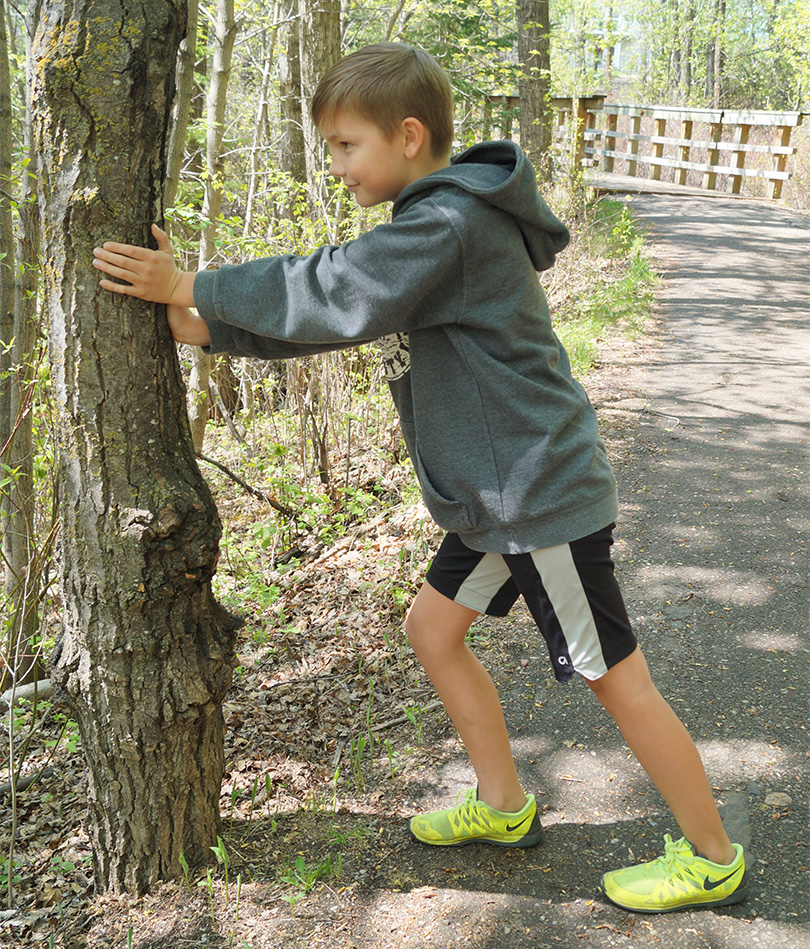
Hold for 30 seconds, repeat 3 times.
Hamstring stretch
Sit on a chair or log with one leg straight in front of you and the other bent; slowly and gently lean forward with your back as straight as possible (rest hands on your knees).

Hold for 30 seconds, and repeat 3 times on each leg.
Thighs and knee stretches
In a standing position, bend one leg at the knee, grab your foot and pull it towards your buttocks. Stand tall and push your pelvis forward and push your thigh backwards.
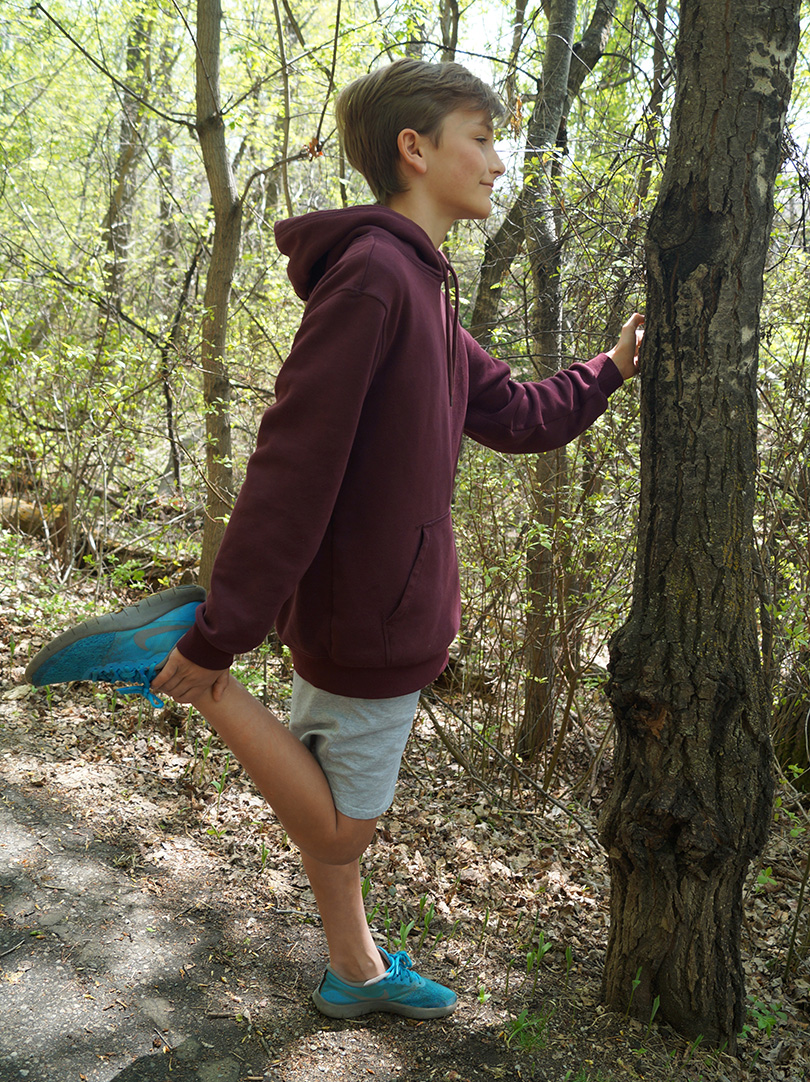
Hold for 30 seconds on each side, repeat 3 times.
Ankle stretch
Roll your ankles clockwise and counterclockwise, 10 times each direction. Make the circles as big as possible.
Back stretches
While lying on your back, keep one leg straight and bring the other knee to your chest and pull it close.
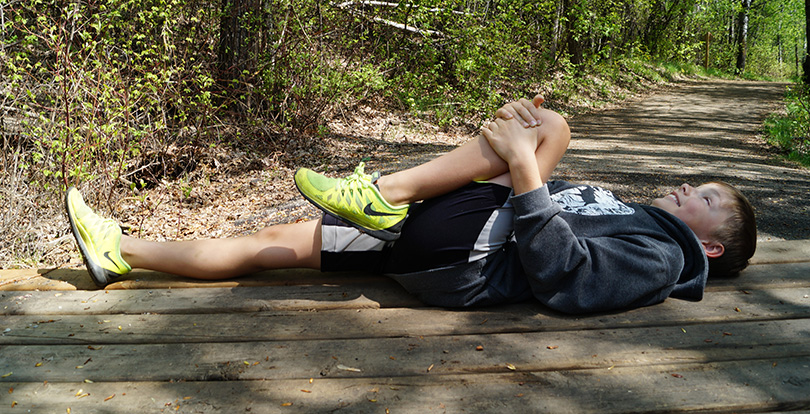
Hold for 30 seconds. Alternate legs and repeat 3 times.
AND
Lie on your back with both knees bent and feet flat on the ground. Have your ankles and knees together. Drop both knees to one side, hold and then swing the knees and drop them to the other side.
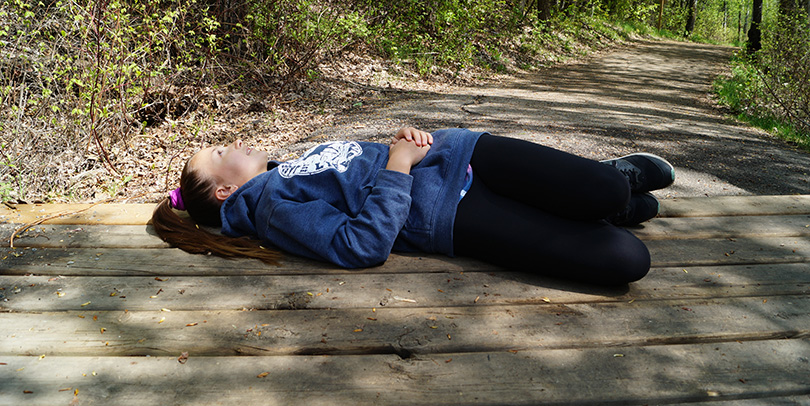
Hold for 30 seconds. Repeat 3 times on each side.
Shoulder stretch
While standing, lift your arm out to the side to about shoulder height, bend your elbow and place it against a wall (or in this case a tree). Slowly turn your body away from your elbow until you feel a nice stretch in your chest area.
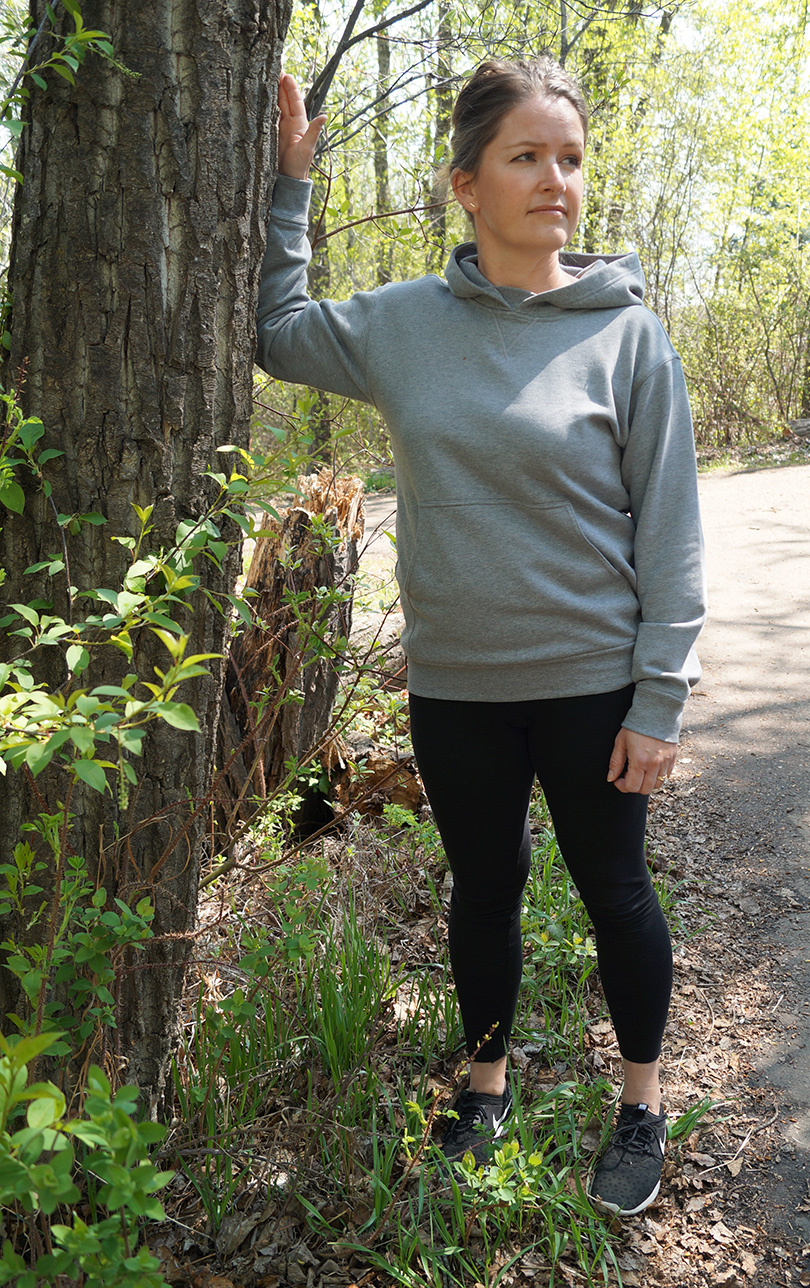
Hold for 30 seconds, repeat 3 times on each side.
Neck stretch
Slowly turn your head right and left, tilt your head right and left and look down. Perform 5 times in each direction.
6. Keep your body moving
If you spend a lot of time lounging at your campsite, remember to take breaks to stand and stretch or go for short walks. Movement will help you avoid aches and pains, and make the most of your outdoor adventure. However, when you’re hiking, make sure you take breaks as well. Give your back and the other joints and muscles in your body a chance to rest and recover. This is also a good time to stay hydrated and have a drink.
Are you planning a camping trip this summer and currently deal with back pain?
To learn more about your back injury and how to avoid injury while camping, book an appointment either online or in-person to chat with one of our physiotherapists.
New clients are always welcome without a doctor’s referral.
